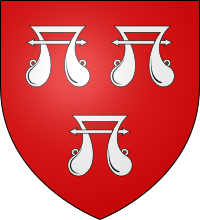Edmund Ros, 10th Baron Ros facts for kids
Quick facts for kids
Edmund Ros, 10th Baron Ros
|
|
|---|---|

Arms of Ros: Gules, three water bougets argent
|
|
| Born | c. 1455 |
| Died | 23 October 1508 Elsyng Palace |
| Father | Thomas Ros, 9th Baron Ros |
| Mother | Philippa Tiptoft |
Edmund Ros, also known as Roos, was the 10th Baron Ros of Helmsley. He was born around 1455 and passed away on October 23, 1508. Edmund was a supporter of the House of Lancaster during the Wars of the Roses. This was a long series of battles fought between two important English families, the Lancasters and the Yorks, who both wanted to rule England. After King Henry VII of England became king, Edmund got his family's noble title back.
Contents
Edmund Ros: A Noble's Story
His Family Background
Edmund de Ros was born around 1455. He was the only son of Thomas Ros, 9th Baron Ros and Philippa Tiptoft. His mother was the daughter of John Tiptoft, 1st Baron Tiptoft.
Edmund had four sisters:
- Eleanor Ros, who married Sir Robert Manners. Their son, George Manners, later became the 11th Baron de Ros.
- Isabel Ros, who married three times. One of her husbands was Sir Thomas Lovell.
- Margaret Ros.
- Joan Ros.
After Edmund's father died, his mother, Philippa, married two more times.
Life During the Wars of the Roses
Edmund's father was declared a traitor by the winning side during the Wars of the Roses. This meant Edmund had to leave England and live in exile. His family's lands and titles were taken away.
However, things changed when Henry VII became king. King Henry VII brought together the families of York and Lancaster, ending the long war. He reversed the decision that had declared Edmund's father a traitor. This meant Edmund was no longer seen as a traitor.
Because of this, Edmund, Lord Ros, got his family's property back. This included Belvoir Castle, which had been held by another family for over twenty years. In 1485, Lord Ros asked Parliament to officially give him back his rights. He spoke calmly about his family's loyalty to King Henry VI and the difficulties they faced.
Managing His Affairs
About nine years later, Sir Thomas Lovell, who was married to Edmund's sister Isabel, asked Parliament for permission to manage Edmund's affairs. Sir Thomas Lovell explained that Edmund needed help managing his property and responsibilities.
Parliament agreed and passed a law. This law gave Sir Thomas Lovell full power over Edmund's person and property. It also stated that after Edmund's death, the property would go to his other relatives. A part of the money from the property was set aside for the King.
Edmund, Lord Ros, lived at a manor called Elsinges in Enfield. He had inherited this manor from his mother. He was likely cared for there.
His Death and Legacy
Edmund died without having any children. He was buried in the church at Enfield. His monument is an arch over the tomb of his grandmother, Lady Joyce Tiptoft. It shows the family's coat of arms.
Since Edmund had no children, his sisters became his heirs. Elsinges manor went to his brother-in-law, Sir Thomas Lovell. When Sir Thomas Lovell died in 1524, he left the manor to his great-nephew, Thomas Manners, 1st Earl of Rutland.
Eleanor, Edmund's oldest sister, had married Sir Robert Manners. She was the grandmother of Thomas Manners, the 1st Earl of Rutland. This shows how the family's legacy continued through his sisters.

